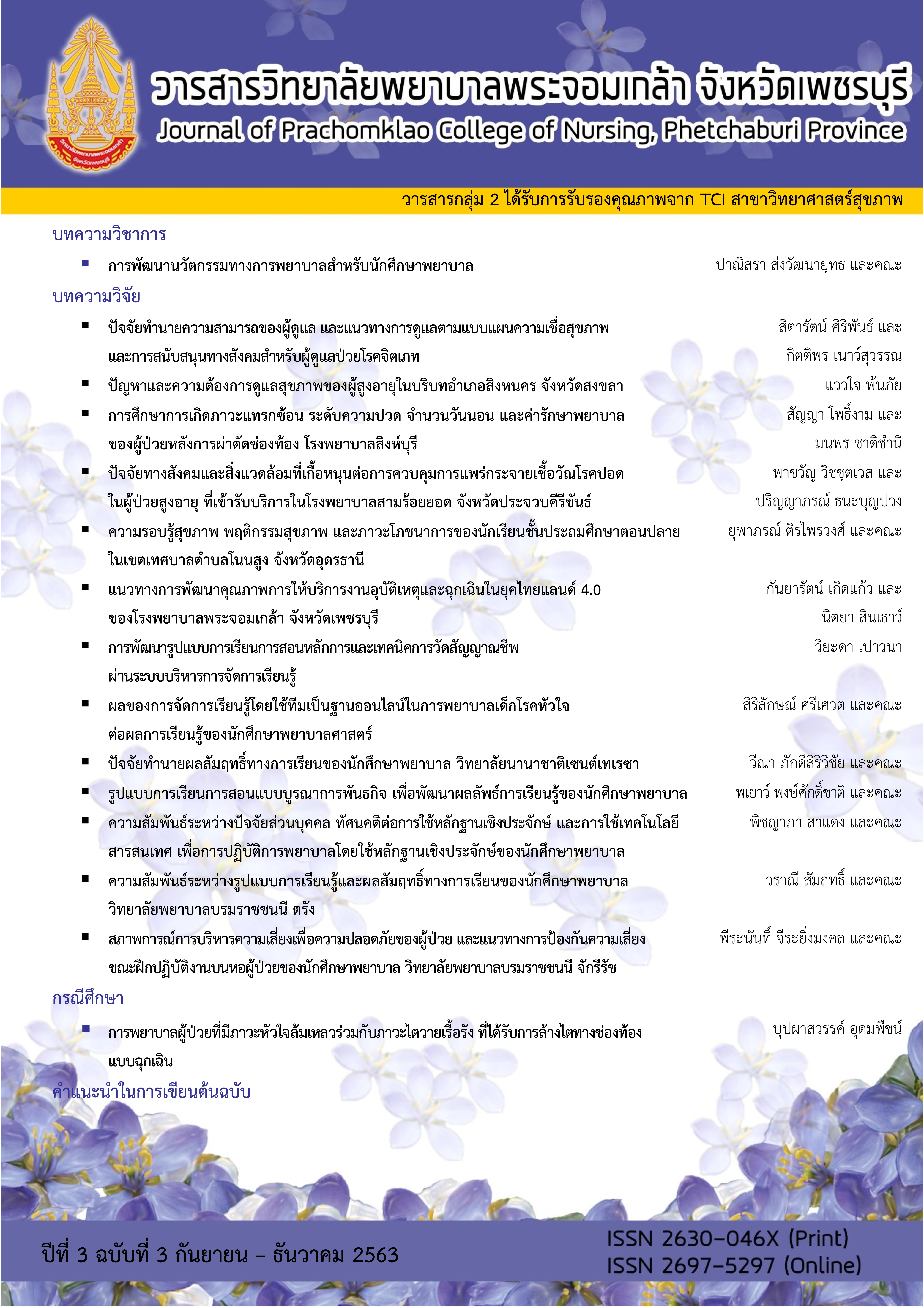The Social and Environmental Supporting Factors of Pulmonary Tuberculosis Transmission-based Precautions in Older Patients, Samroiyod Hospital, Prachuap Khiri Khan Province
Main Article Content
Abstract
This cross-sectional descriptive research aimed to study 1) level of the social and environmental factors and control behavior of pulmonary tuberculosis transmission, 2) to study the relationship between social and environmental factors supporting the control of pulmonary tuberculosis transmission behavior and 3) predictive factors for control of pulmonary tuberculosis transmission behavior of the older patients in Samroiyod Hospital. Simple random sampling was used to recruit 143 older patients. Data were collected by using the questionnaire. Reliability of total scale was .89 and sub scale were .86, .81, .78, .84 respectively. Data were analyzed by using descriptive statistics, Pearson’s product-moment correlation and stepwise multiple regression analysis. The results revealed as follows:
1. The level of community perception of health, social support and control of pulmonary tuberculosis behavior for the older patients was at a high level (M = 4.21, 4.16, 4.26; SD = .73, .66, .56) respectively. The health communication in community was at a moderate level (M = 3.38, SD = .79).
2. The community perception of health in community was high, significantly correlated with control of pulmonary tuberculosis behavior (r =.71, p <.01). The health communication in community and social support were moderate, significantly correlated with control of pulmonary tuberculosis behavior (r =.57, p< .01).
3. The community perception of health, the health communication in community and social support can predict control of pulmonary tuberculosis behavior for the older patients at 41.70% with the significant level of .001.
Downloads
Article Details
Content and information published in the Journal of Prachomklao College of Nursing, Phetchaburi Province are the comment and responsibility of the authors. Articles, information, images, etc. published in this journal are the copyright of the Journal of Prachomklao College of Nursing, Phetchaburi Province. If any person or entity wants to take all or part of it for publication for any purposes, please reference the Journal of Prachomklao College of Nursing, Phetchaburi Province.
References
กองยุทธศาสตร์และแผนงาน สำนักงานปลัดกระทรวงสาธารณสุข. (2561). สถิติสาธารณสุข พ.ศ.2561. สืบค้นจาก http://www.bps.moph.go.th/new_bps/sites/default/files/statistic%2061.
ขวัญใจ มอนไธสง, จีราภรณ์ กรรมบุตร, และวนลดา ทองใบ. (2560). ปัจจัยทำนายพฤติกรรมการป้องกันวัณโรคของผู้สัมผัสร่วมบ้านกับผู้ป่วย วัณโรคปอดที่พักอาศัยในกรุงเทพมหานครและปริมณฑล. วารสารพยาบาลทหารบก, 18(18), 306-314.
เฉวตสรร นามวาท, สุธาสินี คำหลวง, นัยนา ประดิษฐ์สิทธิกร, ยงเจือ เหล่าศิริถาวร, ศศิธันว์ มาแอเคียน, วิธัญญา ปิณฑะดิษ, และอรพรรณ โพธิหัง. (2560). ความคุ้มค่าการลงทุนเพื่อยุติปัญหาวัณโรคในประเทศไทย: การวิเคราะห์ต้นทุน-ผลได้ (รายงานการวิจัยฉบับสมบูรณ์). นนทบุรี: สำนักงานบริหารโครงการกองทุนโลก กรมควบคุมโรค กระทรวงสาธารณสุข. สืบค้นจาก https://www.hitap.net/ wpcontent/uploads/2018.
นงพิมล นิมิตอานันท์, ศศิธร รุจนเวช, และจุฑารัตน์ ผู้พิทักษ์กุล. (2562). รูปแบบการสื่อสารความเสี่ยงทางสุขภาพโรคหลอดเลือดสมอง ตามมิติวัฒนธรรมของกลุ่มชาติพันธุ์ไทยทรงดำ: กรณีศึกษาชุมชนหนึ่งในจังหวัดนครปฐม. วารสารคณะพยาบาลศาสตร์ มหาวิทยาลัยบูรพา, 27(2), 80-92.
บุญชม ศรีสะอาด. (2556). วิธีการทางสถิติสำหรับการวิจัย เล่ม 1 (พิมพ์ครั้งที่ 5). กรุงเทพฯ: สุวีริยาสาส์น.
ปรารถนา วัชรานุรักษ์, และอัจฉรา กลับกลาย .(2560). ปัจจัยที่มีอิทธิพลต่อพฤติกรรมการป้องกันโรคในผู้ป่วยกลุ่มเสี่ยงโรคหลอดเลือดสมองจังหวัดสงขลา. วารสารเครือข่ายวิทยาลัยพยาบาลและการสาธารณสุขภาคใต้, 4(1), 217-233.
ภมร ดรุณ, และประกันชัย ไกรรัตน์. (2562). ปัจจัยความรอบรู้ด้านสุขภาพที่มีอิทธิพลต่อพฤติกรรมสุขภาพ ของประชาชนจังหวัดบึงกาฬ. วารสารวิชาการ กรมสนับสนุนบริการสุขภาพ, 15(3), 71-82.
วัลภา บูรณกลัศ. (2560). ความสัมพันธ์ระหว่างพฤติกรรมการดูแลสุขภาพตนเอง สัมพันธภาพในครอบครัวกับความสุขของผู้สูงอายุในชุมชนแห่งหนึ่ง เขตสายไหม กรุงเทพมหานคร. วารสารพยาบาลตำรวจ, 9(2), 25-33.
สำนักวัณโรค กรมควบคุมโรค. (2560). แผนปฏิบัติการระดับชาติด้านการต่อต้านวัณโรค พ.ศ.2560–2564. กรุงเทพฯ: อักษรกราฟฟิคแอนด์ดีไซน์.
Becker, M. H. (1974). The health belief model and preventive health behavior. Health Education Monographs, 2(4), 354-385.
Cohen, S., & Syme, S. L. (1985). Social support and health. Orlando, FL: Academic Press.
Faul, F., Erdfelder, E., Buchner, A., & Lang, A. G. (2009). Statistical power analyses using G*Power 3.1: Tests for correlation and regression analyses. Behavior Research Methods, 41(4), 1149-1160.
Green, L. W., & Kreuter, M. W. (2005). Health program planning: An educational and ecological approach. New York: Quebecor World Fairfield.
Hinkle, D. E. (1998). Applied statistics for the behavior sciences (4th ed.). New York: Houghton Mifflin.
House, J. S. (1981). Work stress and social support. Boston: Addison-Wesley.
Ratzan, S. C., Payne, J. G., & Bishop, C. (1996). The status and scope of heath communication. Journal of Health Communication, 1(1), 25-41.

